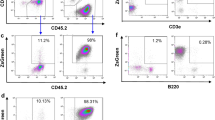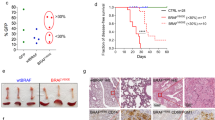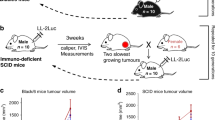Abstract
Neoplastic cells are characterized by partial or total autonomy from the interactions that regulate the behaviour of normal cells in the intact animal. Despite the role of the host cellular environment in governing the proliferation and differentiation of both normal and malignant cells, little is actually known about these host factors. The characterization of host genes that influence both normal cellular processes, as well as susceptibility to tumour induction, is one approach to identifying such factors. Mice carrying two recessive mutations at the steel (Sl) locus have an environmental defect that affects both normal haematopoietic stem cell function1,2 as well as susceptibility to Friend leukaemia virus3–5. In this study, we have used Sl/Sld mice to examine whether malignant transformation by this RNA tumour virus results in a population of cells capable of proliferating even in the defective cellular microenvironment of Sl/Sld mice. We report here that late after infection, the leuk-aemic spleens of Friend virus-infected mice contain cells which, unlike normal haematopoietic stem cells, are able to form macroscopic spleen colonies in irradiated mice of genotype Sl/Sld. This observation forms the basis for the first in vivo colony assay for leukaemic cells transformed by Friend virus.
This is a preview of subscription content, access via your institution
Access options
Subscribe to this journal
Receive 51 print issues and online access
$199.00 per year
only $3.90 per issue
Buy this article
- Purchase on Springer Link
- Instant access to full article PDF
Prices may be subject to local taxes which are calculated during checkout
Similar content being viewed by others
References
McCulloch, E. A., Siminovitch, L., Till, J. E., Russell, E. S. & Bernstein, S. E. Blood 26, 399–410 (1965).
Russell, E. S. Adv. Genet. 20, 357–459 (1979).
Bennett, M., Steeves, R. A., Cudkowicz, G., Mirand, E. A. & Russell, L. B. Science 162, 564–565 (1968).
McCool, D., Mak, T. W. & Bernstein, A. J. exp. Med. 149, 837–846 (1979).
MacDonald, M. E. et al. J. exp. Med. 151, 1477–1492 (1980).
Russell, E. S. & Bernstein, S. E. in The Biology of the Laboratory Mouse (ed. Green, E. L.) 351–372 (McGraw-Hill, New York, 1966).
Till, J. E. & McCulloch, E. A. Radiat. Res. 14, 213–222 (1961).
Bernstein, S. E. Am. J. Surg. 119, 448–451 (1970).
Trentin, J. J. et al. in Morphological and Functional Aspects of Immunity (eds Landahl-Kiessling, K. et al.) 289–298 (Plenum, New York, 1971).
Tambourin, P. E., Wendling, F., Jasmin, C. & Smadja-Joffe, F. Leukemia Res. 3, 117–129 (1979).
Levy, S. B., Blankstein, L. A., Vinton, E. C. & Chambers, T. J. in Oncogenic Viruses and Host Cell Genes (eds Ikawa, Y. & Odaka, T) 409–428 (Academic, New York, 1979).
Bernstein, A., Mak, T. W. & Stephenson, J. R. Cell 12, 287–294 (1977).
Friend, C. & Haddad, J. R. J. natn. Cancer Inst. 25, 1279–1289 (1960).
Friend, C., Scher, W., Holland, J. C. & Sato, T. Proc. natn. Acad. Sci. U.S.A. 68, 378–382 (1971).
Mager, D., Mak, T. W. & Bernstein, A. Proc. natn. Acad. Sci. U.S.A. (in the press).
Liao, S. K. & Axelrad, A. A. Int. J. Cancer 15, 467–482 (1975).
Horoszewicz, J. S., Leong, S. S. & Carter, W. A. J. natn. Cancer Inst. 54, 265–267 (1975).
Ostertag, W., Melderis, H., Steinheider, G., Kluge, N. & Dube, S. Nature new Biol. 239, 231–234 (1972).
Tambourin, P. et al. in In vivo and in vitro Erythropoiesis: The Friend System (ed. Rossi, G. B.) 127–138 (Elsevier, Amsterdam, 1980).
Steeves, R. A., Bubbers, J. E., Plata, F. & Lilly, G. Cancer Res. 38, 2729–2733 (1978).
Wendling, F. & Tambourin, P. E. Int. J. Cancer 22, 479–486 (1978).
Axelrad, A. A. & Steeves, R. A. Virology 24, 513–518 (1964).
Author information
Authors and Affiliations
Rights and permissions
About this article
Cite this article
Mager, D., Mak, T. & Bernstein, A. Friend leukaemia virus-transformed cells, unlike normal stem cells, form spleen colonies in Sl/Sld mice. Nature 288, 592–594 (1980). https://doi.org/10.1038/288592a0
Received:
Accepted:
Issue Date:
DOI: https://doi.org/10.1038/288592a0
This article is cited by
-
Spi-1 is a putative oncogene in virally induced murine erythroleukaemias
Nature (1988)
-
Rearrangements of the cellular p53 gene in erythroleukaemic cells transformed by Friend virus
Nature (1985)
-
A host gene controlling early anaemia or polycythaemia induced by Friend erythroleukaemia virus
Nature (1982)
Comments
By submitting a comment you agree to abide by our Terms and Community Guidelines. If you find something abusive or that does not comply with our terms or guidelines please flag it as inappropriate.



